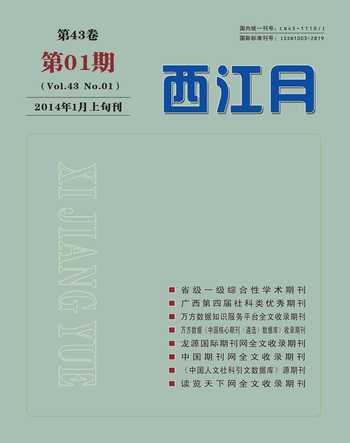Corpus—based Study on Complementizer Usage of Shuo in Written
2014-04-29PekingMandarin
Peking Mandarin(卢正阳)
【Abstract】Saying verb is one of the most highly frequent used words in all languages across the world, and during the course of its long-time usage many complex grammatical usages derived from its original meaning of saying.Within that complex domain of usages, the complementizer usage is an essential part of the whole picture of grammaticalization of saying verbs. In actuality, in some languages saying verbs have become one of the main resources for the occurrence of complementizers (Heine 1991), and in Chinese there also exists that phenomenon.According to Fang(2003), in Peking mandarin once the serial verb construction “speech act verbs + shuo” is forged, the semantic meaning of shuo begins to decay thus producing the possibility that shuo can be reinterpreted as special linking word ushering in content of speech.Similarly, Wang, Y-F., Katz, A. and Chen, C-H(2003), based on their study of grammaticalization of shuo in Taiwan mandarin, proposed that grammaticalizationof the verb shuo into a complementizer evidently begins when the general saying verbshuois used to reinforce a variety of verbs of saying in the matrix clause.
【Key words】grammaticalization, complementizer, shuo, corpus
People are not just saying for sake of saying instead they say what they think, because“semantically, there is a closerelationship between speech and mental processes” (Wang, et al 2003). What is really more important is not the act of saying but how we think of the words being uttered, in what way we would like to say. The matrix verbs in serial verb constructions dominates, while shuo is passively fading into a dominated status, since it is the attitude towards the proposition linked syntactically by shuo and signaled semantically by the matrix verbs that is really important. According to Ranson (1988), one of the functions of a complementizeris to semanticallysignal the modality of the complement proposition. Therefore, the motivation behind the grammaticalizationof shuo into a complementizer pertains to the metaphor--‘SPEECH IS THOUGHT. As this reason stands, it is reasonable to say that theconstant recurring patterns of serial verb constructions should be treated as the inkling of grammaticalization of shuo into a complementizer, and it justifies itself to treat that recurring pattern as a minimum standard to trace any clues of grammaticalization of shuo into a complementizer in any written languages, including Peking mandarin.
So, in this paper, serial verb construction, specifically “speech act verbs + shuo”, will be treated as an inspiration and also a starter for the corpus-based study of complementizer usage of shuo in written Peking mandarin. Starting from that, an exhaustivesearch of the serial verb construction will be conducted in the written Peking mandarin corpus, trying to figure out whether the grammaticalization of shuo has ever sunk into the written Peking mandarin.Plus, the searching result will be compared to that of previous studies on spoken Peking mandarin, detecting out if there is any deviating grammaticalizationway of shuoin written Peking mandarin from that of spoken Peking mandarin.
1.Method
The corpus used by this paper is the written Peking mandarin corpusfrom the CCL (Center for Chinese Linguistics PKU). This sub-corpus is a perfect fit for the research of this paper, as the sub-corpus is by far the most complete with a full range of works of Peking mandarin writers from those available and it is updated lately by 2009. The operating steps towards this corpus are like the following:
Firstly, we went to the advanced searching interface of the online edition of CCL, configuring the Searching Type as Beijing Hua and got a preliminary search result with 21 859 hits. Thereafter, those concordances were downloaded to the local computer in the format of txt, which would undergo a further processing of lexical partition and tagging by the software ICTCLAS 1.0. Afterwards, a further research by Wordsmith 5.0 with the searching expression “?/v 說/v” was done for the tagged downloaded corpus. Those search results of the second search was treated as a rough reference for the exhaustion of serial verb constructions and to guarantee the accuracy, a manual denoising of data was also performed.
2.Findings and discussion
After scrutinizing the data, there are 40 verb serial constructions in total that meet the criteria. In the following table, we can examine those 40 constructions with a descending order of their frequency of occurrence in corpus.
From this table we can see that compared to the 21 859 concordances with shuo in them, the total number of occurrences of shuo in serial verb constructions occupies such a small portion that we are conformed of the initial stage of grammaticalization of shuo in written Peking mandarin again.Also there are 26 types of serial verb constructions of shuo are hapax legomena and the most frequent occurring construction---jieshi shuo appears only 19 times in the corpus.
Sui (2007) proposed that in spoken language, shuo can co-occur with verbs of evidential and epistemological verbs, for example, kanjian (see) and zhidao(know), both of which can be constructed into the serial verb constructions with shuo. Apparently, measuring under this criterion of classification, none of the 40 types of verbs fit into the evidential or epistemological category, since all of them are just saying verbs, except for tingjian (hear), a verb of experience belonging to the category of evidential verbs. But when we examine those 40 serial verb constructions, we did find some insights into how the grammaticalization of shuo came into being in the first place.
